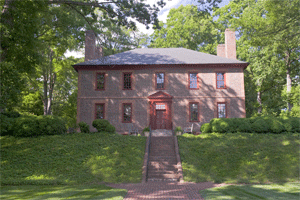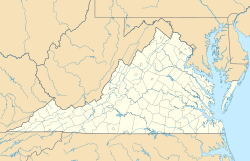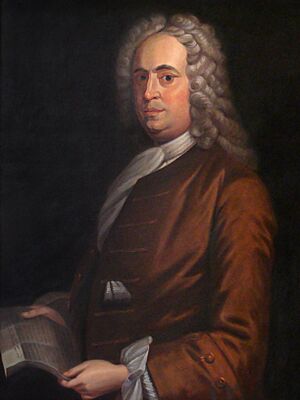Wilton House Museum facts for kids
|
Wilton
|
|
 |
|
| Location | S of Richmond, on N bank of James River, Richmond, Virginia |
|---|---|
| Area | 2 acres (0.81 ha) |
| Built | 1750 |
| Architectural style | Georgian |
| NRHP reference No. | 76002231 |
Quick facts for kids Significant dates |
|
| Added to NRHP | April 30, 1976 |
Wilton House Museum is a museum located in a historic house in Richmond, Virginia. The house was built around 1753 by William Randolph III. He was the son of William Randolph II.
Wilton was originally the main house on a large tobacco plantation. This plantation was about 2,000 acres and was called "World's End." It was located on the north bank of the James River, a few miles east of Richmond. William Randolph III bought many pieces of land between 1747 and 1759. Around 1753, he finished building the house, which he named "Wilton." It had a great view of the river.
In 1934, the house was in danger of being torn down. This was because new buildings were being built nearby. A group called The National Society of The Colonial Dames of America in the Commonwealth of Virginia saved it. They bought the house, took it apart, moved it, and rebuilt it. The new location is a few miles west of its original spot, also overlooking the James River.
Wilton House has been open to the public as a museum since 1952. It displays a collection of furniture, fabrics, glass, ceramics, and silver from the 1700s and 1800s. These items show what life was like for wealthy plantation owners in the mid-1700s. The house was added to the National Register of Historic Places in 1976.
Contents
What is Georgian Architecture?
Wilton House is built in the Georgian style. This was a very popular building style during the Colonial era in America. Georgian architecture looked a bit different depending on the region. This was due to the climate and what building materials were available. However, it usually followed a balanced, rectangular design. Its simple, grand look came from an older style called Palladian architecture.
The History of Wilton House
The Randolph Family's Story
In the 1600s, the Randolph family of Virginia was one of the richest and most powerful families in Colonial Virginia. William Randolph and his wife, Mary Isham Randolph, are often called "the Adam and Eve of Virginia." Many famous people came from their family. These include President Thomas Jefferson and General Robert E. Lee.
Wilton was built around 1753 for William Randolph III and his wife, Anne Harrison Randolph. It was part of a 2,000-acre plantation. William Randolph III was a planter and served the public. He was a member of the House of Burgesses for Henrico County. He also served as an officer in the local militia.
Wilton stayed in the Randolph family for many years. After William Randolph III, his son Peyton Randolph owned it. Then it passed down through several generations until 1859. Wilton survived the American Civil War. It changed owners four more times after that. During the Great Depression, the house was almost lost. The National Society of The Colonial Dames of America in the Commonwealth of Virginia stepped in. They bought the house and saved it.
At Wilton, the Randolph family forced over 100 African American men, women, and children into slavery. These enslaved people built the house and worked on the plantation. Their labor produced crops like wheat and tobacco, which made money for the Randolphs. By the early 1800s, Wilton had the largest enslaved community in Henrico County.
- William Randolph III passed away in 1762 at age 52. He left Wilton to his 23-year-old son, Peyton Randolph.
- Peyton Randolph passed away in 1784 at age 46. He left Wilton to his five-year-old son, William Randolph IV.
- William Randolph IV passed away in 1815 at age 26. He left Wilton to his five-year-old son, Robert Randolph. His wife, Anne Andrews Randolph, managed the plantation.
- Robert Randolph passed away in 1839 at age 29. He left Wilton, which had many debts, to his four-year-old daughter, Catherine (Kate).
- Catherine was the last Randolph family member to own Wilton. She filed a lawsuit to sell the house in 1859.
Wilton in the 1700s
Wilton was first located on a 2,000-acre tobacco plantation. This was about 9 miles downriver from Richmond. The large, two-story brick house was one of the most important plantation homes on the James River.
- In 1742, William Randolph III inherited land from his father.
- In 1747, William III bought over 1,000 acres from William Finney Jr.
- Also in 1747, he bought 350 acres from Richard Randolph.
- In 1747, he bought 150 acres from William Bayley.
- In 1749, he bought 136 acres from Arthur Giles.
- In 1752, 25 acres were described as "next to the land of Randolph whereon he now lives called Wilton."
Wilton in the 1800s
William Randolph IV's will allowed his wife to sell any property to pay off his debts. In 1833, a writer named Catharine Sedgwick visited Wilton. She described "Broken down fences, a falling piazza, defaced paint, banisters ties up with ropes." She added that the house looked like a "forlorn ruin." The value of the Wilton estate dropped a lot. It went from $74,664 in 1832 to $45,066 in 1850. Wilton continued to decline.
In 1833 and 1835, Robert Randolph had to put the plantation in a trust. This was to secure larger and larger debts. Robert Randolph passed away in 1839. He left Wilton, which was heavily in debt, to his daughter, Catherine. Four years after Robert's passing, his wife, Mary, married James Brook. In 1846, James and Mary filed a lawsuit. They wanted to divide the property with Catherine S. Randolph. Wilton was split into two parts. James and Mary got 744 acres, and Catherine got 1,535 acres.
In 1859, Catherine filed a lawsuit to sell Wilton. The case was not settled until 1875. Records from the time show that the soil on the plantation was not as good as it used to be. This was because of hard farming over the years. The buildings were also in bad shape. The auction happened on July 27, 1859. William C. Knight paid $49,517 for 1,237.93 acres, which included the house. Catherine was the last Randolph family member to own Wilton.
Wilton in the 1900s
During the Great Depression, Wilton was in danger of being taken by the bank. In 1933, The National Society of The Colonial Dames of America in the Commonwealth of Virginia bought it. They moved and rebuilt the house along the James River. This new location is about 15 miles west of where it first stood.
The Museum Collection
Wilton is the only public plantation home from the 1700s in Richmond. It has a collection of 1,400 historical items. These pieces are from the 1600s, 1700s, and 1800s. They include silver, ceramics, fabrics, paintings, old papers, and furniture.
Images for kids
















